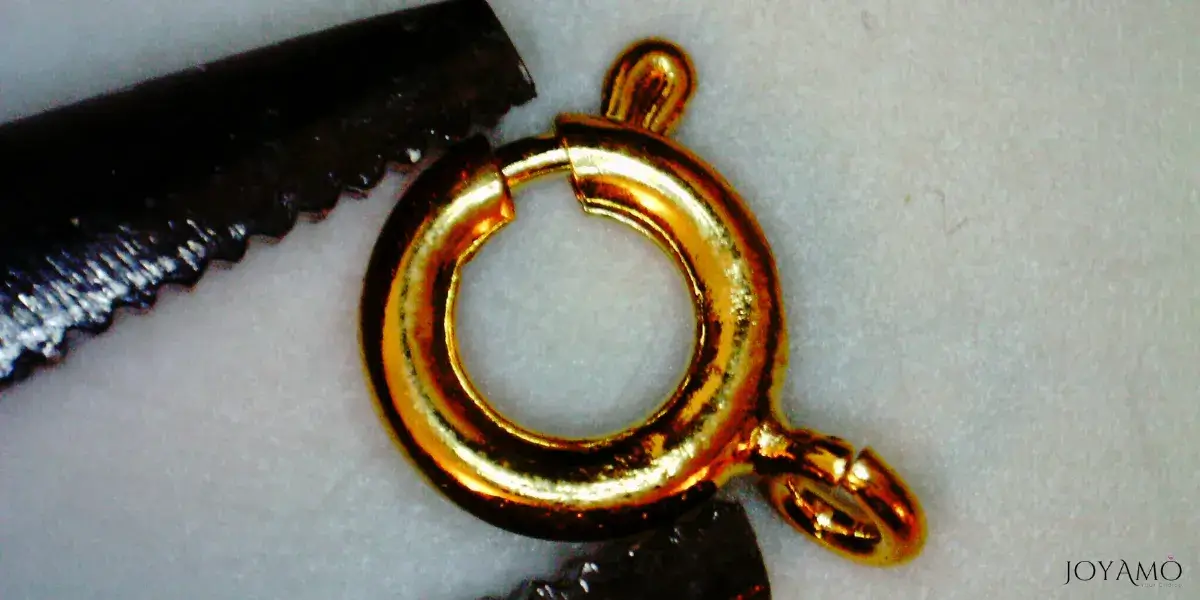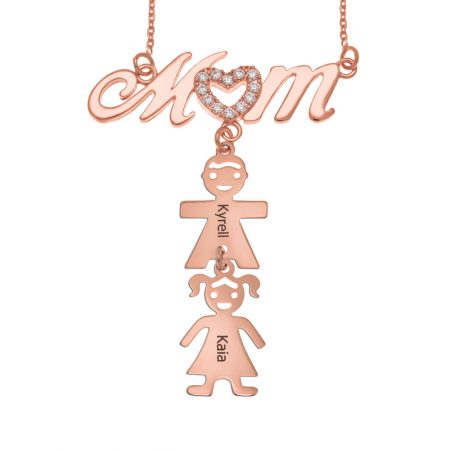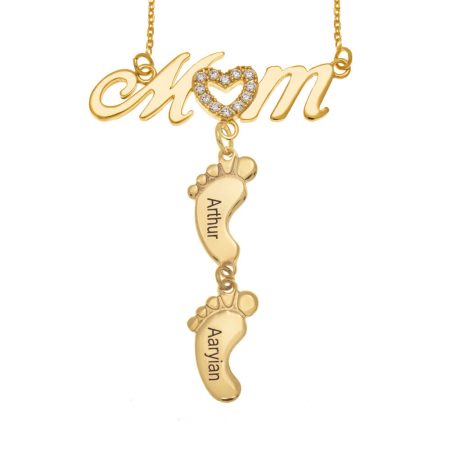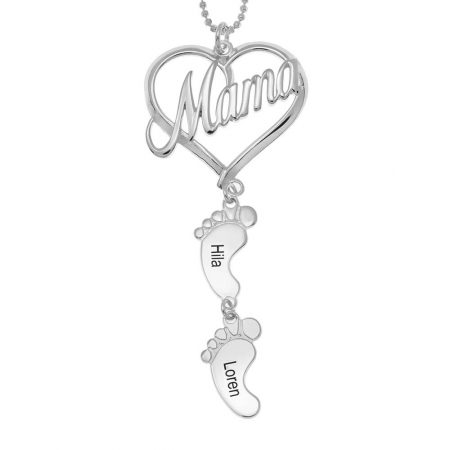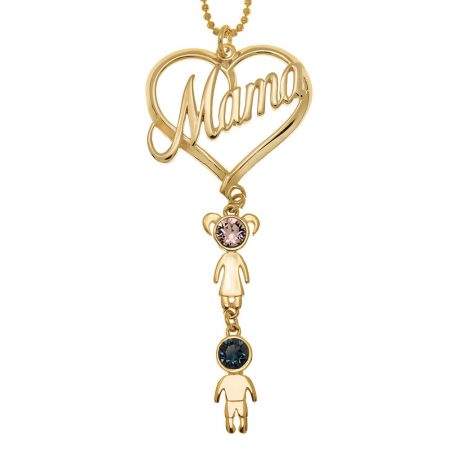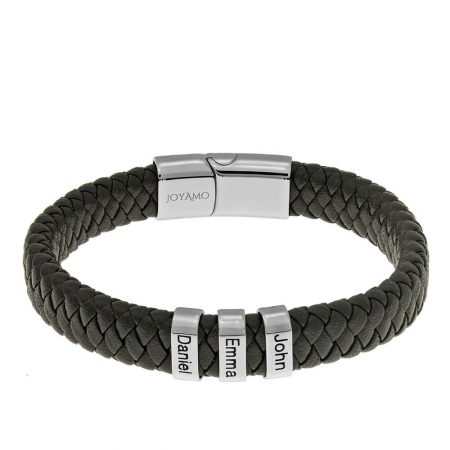Jewelry clasp play a role in every accessory, blending practicality with fashion.
From timeless lobster clasps to box clasps, these small elements ensure that your necklaces and bracelets remain secure and stylish.
Whether you fancy the simplicity of a spring ring or the elegance of a toggle clasp there’s a closure to complement every style and aesthetic.
Meticulously crafted with precision and care, clasps not only safeguard your jewelry but also elevate the sophistication of any outfit.
I. Clasps in Jewelry Design
Clasps are essential in jewelry design serving as both fastenings and decorative elements.
These important components are often underestimated but play a vital role in securing necklaces chains, bracelets chains, and other accessories while adding a touch of elegance to the overall design.
Even a beautiful necklace or bracelet would lack practicality and feel unfinished without a clasp.
📌 Necklace Clasps: Combining Style and Security
Necklaces are pieces of jewelry that enhance the neckline with sophistication and charm.
The centerpiece of any necklace is its clasp, the hero that keeps everything together and allows it to elegantly adorn the wearer’s neck.
The choice of clasp can significantly influence both the functionality and beauty of a necklace.
📌 Bracelet Clasps: Combining Form and Function
Bracelets, like necklaces, also depend on clasps to guarantee a snug and comfortable fit around the wrist.
There are many different types of bracelet clasps; each is made to blend in with the bracelet’s overall look and be comfortable to wear.
II. Common Types of Necklace Clasps
SPRING RING CLASP

Popular jewelry closures that are renowned for their dependability and simplicity include the spring ring clasp. It is made of a tiny metal ring that opens and shuts by pressing on a tiny lever. The mechanism is spring-loaded. Because of its user-friendliness and firm grip, this clasp is frequently employed in bracelets and necklaces. It does, however, have advantages and disadvantages like any jewelry element. A summary of the features of the spring ring clasp may be found in the table below.
| Description | Advantages | Disadvantages |
|---|---|---|
| Small, discreet design | Easy to use | Small size can be challenging for individuals with limited dexterity |
| Secure closure | Widely available | The Spring mechanism may weaken over time with frequent use |
| Versatile | Compatible with various jewelry styles | Not suitable for heavy or large pieces |
LOBSTER CLAW CLASP
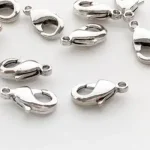
A common closure in jewelry design, the lobster claw clasp, is admired for its strength and firm grip. This lobster-claw-like clasp has a tiny lever that opens and shuts the mechanism to provide a secure hold when it is attached. Because of its sturdy design, wearers can feel secure wearing heavier necklaces and bracelets. But there are benefits and drawbacks to take into account. For a detailed description of the lobster claw clasp, see the table below.
| Description | Advantages | Disadvantages |
|---|---|---|
| Strong and durable | Secure closure | Small size can be challenging to manipulate for some individuals |
| Sleek and streamlined design | Widely available | May cause wear on delicate chains over time |
| Compatible with various jewelry styles | Provides a professional finish to jewelry pieces | Requires more effort to fasten compared to other types of clasps |
BAYONET CLASP
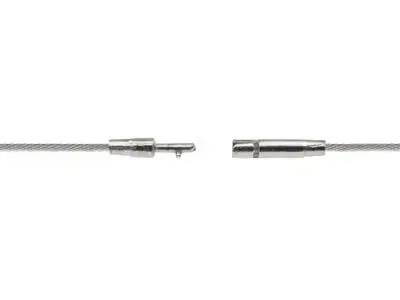
The bayonet clasp, also referred to as the tube and bar clasp is a reliable fastener often seen in necklaces and bracelets. It features a tube (the bar) that smoothly inserts into a cylinder (the tube) creating a seamless connection upon twisting and securing in place. This type of clasp brings a contemporary look making it a popular option, for jewelry designs. However, like any closure mechanism, it comes with its set of pros and cons. Take a look at the table below for an in-depth breakdown of the characteristics of the bayonet clasp.
| Description | Advantages | Disadvantages |
|---|---|---|
| Sleek and modern design | Secure closure | Requires twisting and alignment for fastening, which can be tricky for some wearers |
| Provides a seamless look | Durable construction | Limited availability compared to more common clasps |
| Suitable for minimalist jewelry designs | Offers a unique aesthetic appeal | May cause wear on chains or cords over time |
BARREL CLASP
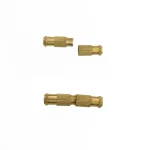
The barrel clasp is a classic and reliable closure commonly used in necklaces and bracelets. Its design features a cylindrical barrel with an inset screw mechanism that fastens securely when twisted shut. This clasp provides a secure hold while maintaining a seamless and elegant appearance. However, it also has its own set of advantages and disadvantages. Check out the table below for a comprehensive overview of the barrel clasp’s characteristics.
| Description | Advantages | Disadvantages |
|---|---|---|
| Secure closure | Classic and timeless design | Requires dexterity to fasten and unfasten |
| Sleek and inconspicuous | Provides a seamless look | Screw mechanism may become loose over time |
| Compatible with various jewelry styles | Durable construction | May cause wear on chains or cords over time |
OPEN BOX CLASP
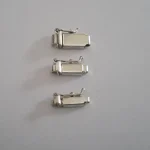
The open-box clasp, also known as the push-button clasp, is a convenient and secure closure commonly used in bracelets and necklaces. Its design features a box-like enclosure with a spring-loaded button that opens the clasp when pushed. This clasp provides a reliable hold while offering ease of use for wearers. However, it also comes with its own set of advantages and disadvantages. Take a look at the table below for a detailed breakdown of the open-box clasp’s characteristics.
| Description | Advantages | Disadvantages |
|---|---|---|
| Easy to open and close | Secure closure | Button mechanism may wear out with frequent use |
| Sleek and modern design | Provides a seamless look | Requires regular maintenance to ensure functionality |
| Compatible with various jewelry styles | Convenient for wearers | May be more prone to accidental opening compared to other clasps |
TOGGLE CLASP
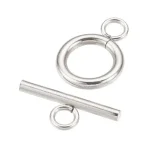
The toggle clasp, distinguished by its T-shaped bar and circular loop, is a versatile and decorative closure commonly used in bracelets and necklaces. Its design offers both functionality and aesthetic appeal, providing a secure hold while adding visual interest to jewelry pieces. However, like any clasp, it has its own set of advantages and disadvantages. In the table below you will find a comprehensive overview of the toggle clasp’s characteristics.
| Description | Advantages | Disadvantages |
|---|---|---|
| Decorative design | Secure closure | Size may not be suitable for delicate or lightweight jewelry |
| Provides a unique aesthetic touch | Easy to fasten and unfasten | T-bar may slip out of the loop if not properly secured |
| Versatile and compatible with various jewelry styles | Adds visual interest to jewelry pieces | Not ideal for individuals with limited dexterity |
BOX CLASP
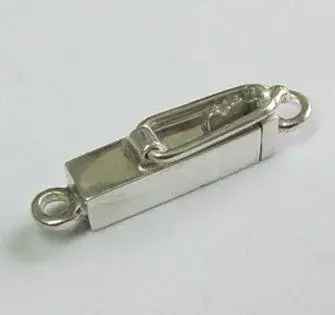
The box clasp, a traditional yet reliable closure, is commonly used in both necklaces and bracelets, offering security and sophistication. Its design features a small box-like enclosure with a hidden latch mechanism that opens when pressed. This clasp provides a secure hold for jewelry pieces while maintaining a seamless and elegant appearance. However, it also has its own set of advantages and disadvantages. Refer to the table below for an overview of the box clasp’s characteristics.
| Description | Advantages | Disadvantages |
|---|---|---|
| Secure closure | Classic and timeless design | Requires dexterity to open and close |
| Sleek and inconspicuous | Provides a seamless look | Latch mechanism may wear out with frequent use |
| Compatible with various jewelry styles | Offers a professional finish to jewelry pieces | May cause wear on chains or cords over time |
MAGNETIC CLASP
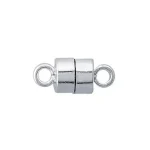
The magnetic clasp, a modern and convenient closure, is gaining popularity in jewelry design, especially for bracelets and necklaces. Its design features two magnetized components that attract and snap together, providing a secure hold without the need for traditional fastening mechanisms. This clasp offers ease of use for wearers, particularly those with limited dexterity. However, it also comes with its own set of advantages and disadvantages. Check out the table below for a detailed breakdown of the magnetic clasp’s characteristics.
| Description | Advantages | Disadvantages |
|---|---|---|
| Convenient and easy to use | Secure closure | Not suitable for heavy or large jewelry pieces |
| Sleek and modern design | Provides a seamless look | May lose magnetic strength over time |
| Compatible with various jewelry styles | Ideal for individuals with limited dexterity | May accidentally detach if not properly aligned |
FISH HOOK CLASP
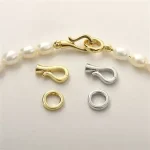
The fish hook clasp, reminiscent of a fisherman’s hook, is a classic and versatile closure commonly used in necklaces and bracelets. Its design features a hook-shaped component that inserts into a loop or eyelet, creating a secure closure. This clasp provides a rustic and handmade aesthetic while offering ease of use for wearers. However, it also has its own set of advantages and disadvantages. Refer to the table below for a comprehensive overview of the fish hook clasp’s characteristics.
| Description | Advantages | Disadvantages |
|---|---|---|
| Rustic and versatile design | Easy to fasten and unfasten | May require additional security measures for heavier jewelry pieces |
| Adds a handmade touch to jewelry pieces | Provides a unique aesthetic appeal | Hook may accidentally catch on clothing or hair |
| Compatible with various jewelry styles | Ideal for casual and bohemian-inspired designs | May be challenging for individuals with limited dexterity |
SWIVEL S- HOOK CLASP
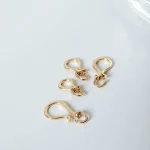
The swivel S-hook clasp, a variation of the classic S-hook closure, is a versatile and secure option commonly used in necklaces and bracelets. Its design features an S-shaped hook that swivels to open and close, providing a reliable hold for jewelry pieces. This clasp offers ease of use and a sleek appearance, making it a popular choice for various styles of jewelry. However, it also has its own set of advantages and disadvantages. In the table below for a detailed breakdown of the swivel S-hook clasp’s characteristics.
| Description | Advantages | Disadvantages |
|---|---|---|
| Secure closure | Easy to fasten and unfasten | The swivel mechanism may wear out with frequent use |
| Sleek and inconspicuous design | Provides a seamless look | May accidentally detach if not properly closed |
| Compatible with various jewelry styles | Offers versatility in jewelry design | Requires careful alignment for closure |
MYSTERY CLASP
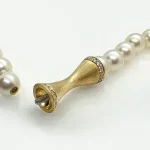
The mystery clasp, also known as a concealed clasp, is a unique and intriguing closure often used in high-end jewelry pieces. Its design features a hidden mechanism that seamlessly blends into the overall aesthetic of the jewelry, creating an air of mystery and sophistication. This clasp provides a secure hold while maintaining a sleek and seamless appearance. However, due to its concealed nature, it may require some practice to master its operation. Check the table below for a comprehensive overview of the mystery clasp’s characteristics.
| Description | Advantages | Disadvantages |
|---|---|---|
| Elegant and sophisticated design | Provides a seamless look | Requires practice to master operation |
| Secure closure | Offers a touch of mystery to jewelry pieces | May be more expensive due to intricate design |
| Compatible with various jewelry styles | Ideal for high-end and luxury pieces | Limited availability compared to more common clasps |
BALL CLASP
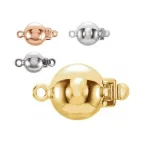
The ball clasp, a classic and timeless closure, is commonly used in necklaces and bracelets for its simplicity and elegance. Its design features a spherical or ball-shaped component that fits into a corresponding socket, creating a secure closure. This clasp offers a sleek and understated aesthetic while providing a reliable hold for jewelry pieces. However, it also has its own set of advantages and disadvantages. As follows, the table below will show a detailed breakdown of the ball clasp’s characteristics.
| Description | Advantages | Disadvantages |
|---|---|---|
| Classic and elegant design | Secure closure | May require some dexterity to fasten and unfasten |
| Sleek and inconspicuous | Provides a seamless look | Ball may become loose over time with frequent use |
| Compatible with various jewelry styles | Offers versatility in jewelry design | May be more prone to accidental opening compared to other clasps |
BOLO CLASP
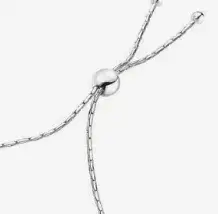
The bolo clasp, also known as a slide clasp, is a versatile and adjustable closure commonly used in necklaces and bracelets. Its design features a sliding mechanism that allows the wearer to adjust the length of the jewelry piece to their preference. This clasp offers flexibility and ease of use, making it ideal for individuals who enjoy customizable jewelry. However, it also has its own set of advantages and disadvantages. The table below has a comprehensive overview of the bolo clasp’s characteristics.
| Description | Advantages | Disadvantages |
|---|---|---|
| Versatile and adjustable design | The slide mechanism may become loose over time | Slide mechanism may become loose over time |
| Easy to use | Provides flexibility in jewelry length | May be more prone to accidental opening compared to other clasps |
| Compatible with various jewelry styles | Offers ease of wear for individuals with limited dexterity | May require occasional adjustments to maintain desired length |
III. Choosing the Right Clasp for Your Necklace
Deciding on the closure for your necklace is a choice that impacts both its practicality and appearance.
There are factors to keep in mind when selecting a closure to ensure it not only complements your necklace but also offers the desired level of security and convenience.
📌 Material and Weight of the Necklace
The material and weight of your necklace are considerations in determining the type of closure that’s suitable. Heavier necklaces require durable closures to provide support and prevent damage. For instance, delicate chains may benefit from closures like spring rings or lobster clasps while heavier chains may necessitate options such as toggle clasps or box clasps.
📌 Security Needs
Evaluate the level of security you need for your necklace. If you wear your necklace regularly. Engage in activities that could subject it to movement or strain opt for a closure with a fastening, such as a lobster clasp or box clasp. These closures offer a grip. Reduce the chances of accidental opening.
📌 User Friendliness
The ease of use is another factor to consider, for individuals, with limited hand strength or mobility challenges. Choose a closure that’s easy to operate and can be manipulated without difficulty.
Spring ring clasps and magnetic clasps offer easy ways to fasten your necklace.
📌 Regarding Style and Aesthetics
It’s important to pick a clasp that matches the look and feel of your necklace enhancing its appeal. Take into account the clasp’s shape, color, and finish to make sure it blends seamlessly with the necklace. For instance, a contemporary necklace could look great with a barrel clasp while a vintage piece might be complemented by a toggle clasp.
📌 Tips for Coordinating the Clasp with the Necklace Design
Look at the design elements and patterns in your necklace when choosing a clasp. Opt for one that fits well with these elements and improves the coherence of the design. Also, think about where you place the clasp so it doesn’t disrupt the flow or balance of your necklace.
By considering these aspects and following these suggestions you can select a clasp for your necklace that combines functionality with style creating a secure yet fashionable accessory, for any event.
IV. Jewelry safety clasps
Jewelry safety clasps are essential components that provide added security and peace of mind for wearers.
Among the various types of safety clasps, three common options stand out: the safety chain, single latch safety, and double latch safety, each offering unique features and benefits.
Safety Chain
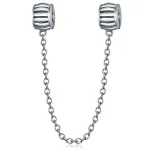
A safety chain is a secondary chain attached to the clasp of a bracelet or necklace, providing an extra layer of security in case the primary clasp fails. It typically consists of a series of small links that connect to both ends of the jewelry piece.
Advantages
- Provides additional protection against accidental opening of the primary clasp.
- Offers peace of mind for wearers, especially when wearing valuable or sentimental jewelry.
Disadvantages
- May add extra weight and bulk to the jewelry piece.
- Requires proper attachment and maintenance to be effective.
Single Latch Safety
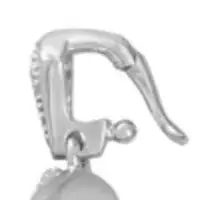
The single latch safety clasp features a spring-loaded latch mechanism that securely locks into place when closed. It is commonly used in bracelets and necklaces to prevent accidental opening of the primary clasp.
Advantages
- Easy to operate with one hand.
- Provides a secure closure for jewelry pieces.
Disadvantages
- May be prone to accidental opening if not properly engaged.
- Requires periodic inspection and maintenance to ensure proper functionality.
Double Latch Safety
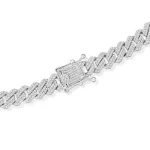
The double latch safety clasp incorporates two latch mechanisms that must be simultaneously engaged to open the clasp, offering enhanced security. It is often used in high-value or heavy-duty jewelry pieces.
Advantages
- Provides double the security compared to single-latch clasps.
- Offers peace of mind for wearers, especially when wearing valuable or heavy jewelry.
Disadvantages
- Can be more difficult to operate than single-latch clasps.
- May require more effort to engage both latches simultaneously.
| Safety Clasp Type | Description | Advantages | Disadvantages |
|---|---|---|---|
| Safety Chain | The secondary chain attached to the primary clasp | Provides additional security | Adds weight and bulk to jewelry |
| Single Latch Safety | Spring-loaded latch mechanism | Easy to operate, secure closure | Prone to accidental opening |
| Double Latch Safety | Two latch mechanisms | Enhanced security | Difficult to operate, requires more effort |
With these jewelry safety clasps, you can choose the option that best suits their needs and preferences, ensuring their jewelry remains secure and protected at all times.
IV. Clasp-Free Jewelry
Clasp-free jewelry offers a seamless and hassle-free way to adorn oneself with elegance and style.
These designs prioritize comfort and convenience without compromising on aesthetics.
Here are some popular clasp-free jewelry styles:
📌 Endless Necklaces
Endless necklaces boast a clasp-free design, allowing for uninterrupted flow and effortless wear. Typically crafted with beads or pearls, these necklaces are long enough to be slipped over the head without any struggle.
Advantages
- Quick and effortless to put on and take off.
- Offers a snug fit without the need for clasps.
Disadvantages
- Limited adjustability in size.
📌 Slip-on Bracelets
Slip-on bracelets, often in the form of bangles or cuffs, feature a wide opening that allows for easy wearing. Simply squeeze your hand inward and slide the bracelet on. Once in place, it securely stays on your wrist.
Advantages
- Quick and effortless to put on and take off.
- Offers a snug fit without the need for clasps.
Disadvantages
- Limited adjustability in size.
📌 Stretch Bracelets
Stretch bracelets are designed with a coil or elastic cord that allows them to stretch and conform to fit most wrists comfortably. This adjustable style eliminates the need for clasps.
Advantages
- Fits a wide range of wrist sizes.
- Easy to put on and remove.
Disadvantages:
- Elastic may lose elasticity over time.
With clasp-free jewelry, individuals can enjoy the ease and simplicity of wearing accessories that effortlessly elevate their style.
| Jewelry Style | Description | Advantages | Disadvantages |
|---|---|---|---|
| Endless Necklaces | Clasp-free design, long enough to slip over the head | Uninterrupted flow, versatile layering | Limited to specific lengths |
| Slip-on Bracelets | Wide opening for easy wearing | Quick and effortless, snug fit | Limited adjustability |
| Stretch Bracelets | Coil or elastic cord for adjustable fit | Fits various wrist sizes, easy to wear | Elastic may lose elasticity |
V. Tips for Maintaining and Repairing Necklace Clasps
Taking care of and fixing necklace clasps is crucial, for keeping your jewelry pieces in shape and working order.
To make sure your clasps last long here are some tips to follow:
✔ Firstly regularly check your clasps for any signs of wear like parts or tarnishing. Fixing issues can prevent bigger problems later.
✔ Secondly clean your clasps often with soap and water to get rid of dirt, grease, and debris. If you have metal clasps try using a polishing cloth to bring their shine and remove any tarnish.
✔ Thirdly store your necklaces properly to avoid tangling and protect the clasps from damage. Use jewelry boxes or pouches to keep each necklace separate and shielded from scratches.
Common problems with clasps include misalignment, worn-out springs, or broken parts.
If you come across any of these issues consider getting help for repairs or try fixing them yourself with jewelry tools.
VI. Historical and Cultural Significance of Necklace Clasps
The significance of the necklace clasp in history and culture spans centuries weaving together a tapestry of traditions and skilled craftsmanship.
Originating from time, necklace clasps have transformed from functional closures to elaborate works of art that mirror the aesthetic tastes and cultural values of different societies.
For instance, in Egypt, necklace clasps often featured designs like the Ankh symbolizing life or the Eye of Horus representing protection.
These clasps not only served as closures but also held spiritual meaning as protective talismans.
Similarly in Greece and Rome, necklace clasps were intricately crafted with designs inspired by mythology and nature.
Clasps adorned with depictions of deities were highly valued for their symbolism and visual appeal.
Various cultures across history have devised clasp mechanisms tailored to their needs and preferences.
In China, traditional necklace clasps are known for their knotwork symbolizing unity and longevity.
In Japan the tradition of using decorative obijime cords as necklace fasteners is deeply rooted in the country’s legacy reflecting the grace and sophistication of artistry.
The Industrial Revolution spurred advancements in clasp design by improving manufacturing methods to create mass-produced clasps that were affordable and long-lasting.
Despite this many cultures still value craftsmanship and artisanal skills with artisans upholding practices to craft clasps that are not just functional but also pieces of art.
Today necklace clasps remain elements in jewelry design serving as both fastenings and symbolic decorations.
Made from metals or embellished with designs clasps continue to hold significance in connecting individuals to their heritage and personal style.
With their cultural importance necklace clasps stand as timeless symbols of human ingenuity and skillful craftsmanship.
VII. Matching Necklaces with Clasps for Every Chain Type
A crucial component of jewelry design is the relationship between necklaces and clasps, especially when taking the kind of chain the necklace is made of into account.
Certain clasps are needed for different kinds of chains to guarantee a stable and aesthetically pleasing fit.
Let’s check out this connection in more detail, concentrating on some of the most well-liked chain types:
📌 Cable Chain
- Description: Cable chains are characterized by uniformly sized round or oval links connected in a simple, straight pattern.
- Clasp Type: Lobster clasp or spring ring clasp.
- Advantages: These clasps offer secure closures suitable for everyday wear.
📌 Box Chain
- Box chains feature square links connected in a symmetrical pattern, creating a sleek and modern look.
- Clasp Type: Box clasp or lobster clasp.
- Advantages: Box clasps provide a secure and seamless closure that complements the clean lines of the chain.
📌 Figaro Chain
- Figaro chains consist of alternating long links and shorter links, creating a distinctive and versatile design.
- Clasp Type: Lobster clasp or spring ring clasp.
- Advantages: These clasps offer ease of use and secure fastening for the unique Figaro chain design.
📌 Rope Chain
- Rope chains feature twisted or braided strands that resemble the texture of a rope.
- Clasp Type: Spring ring clasp or barrel clasp.
- Advantages: Barrel clasps provide a secure closure that complements the intricate texture of rope chains.
| Chain Type | Description | Recommended Clasp Type |
|---|---|---|
| Cable Chain | Uniform round or oval links | Lobster Clasp, Spring Ring Clasp |
| Box Chain | Square links in a symmetrical pattern | Box Clasp, Lobster Clasp |
| Figaro Chain | Alternating long and short links | Lobster Clasp, Spring Ring Clasp |
| Rope Chain | Twisted or braided strands resembling a rope | Spring Ring Clasp, Barrel Clasp |
Jewelry designers can guarantee a smooth and safe connection that improves the piece’s overall visual attractiveness by matching the clasp to the type of chain used in a necklace.
A harmonious and fashionable jewelry design depends on the relationship between necklaces and clasps, whether you choose a sophisticated box chain with a box clasp or a traditional cable chain with a lobster clasp.
💡 Necklace clasp types FAQs
👉🏻 What is the best clasp for a bracelet?
The best clasp for a bracelet often depends on personal preference and the style of the bracelet. However, a lobster clasp is a popular choice due to its reliability, ease of use, and secure closure, making it suitable for various bracelet designs.
👉🏻 What is the most secure type of clasp?
The most secure type of clasp is typically considered to be a double latch safety clasp. This type of clasp features two latch mechanisms that must be engaged simultaneously, providing enhanced security and minimizing the risk of accidental opening.
👉🏻 What is the strongest clasp for a chain?
For a chain, the strongest clasp option is often a box clasp. Box clasps feature a sturdy design with a tongue mechanism that fits securely into a box-shaped enclosure, offering a strong and reliable closure for heavier chains.
👉🏻 What is an open box clasp?
An open box clasp is a type of jewelry closure that consists of a box-shaped enclosure with an open top. The tongue of the clasp fits into the box, securing the closure. This type of clasp provides a sleek and minimalist look while offering a secure hold for necklaces and bracelets.
 SHIPPING
SHIPPING
